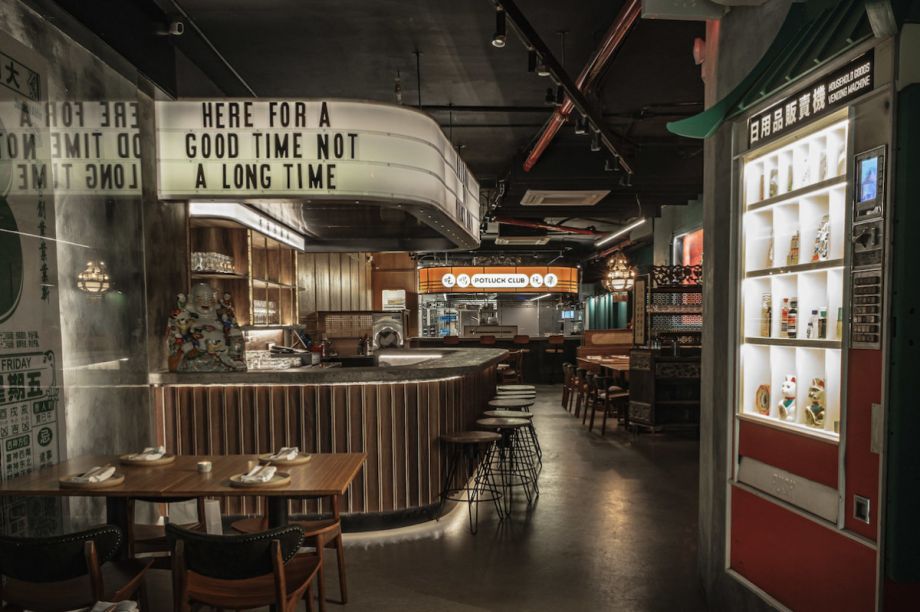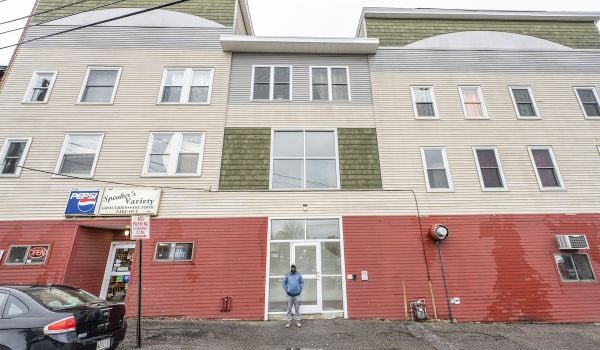Chef Zhan Chen and a handful of childhood friends from Chinatown are celebrating the first birthday of the Potluck Club, the restaurant they created to put their own generational spin on their families’ and neighborhood’s beloved culture.
At the same time, they’re growing more concerned every day about how their restaurant is supposed to overcome the triple-threat of a massive jail construction project, the constant specter of anti-Asian American violence, and post-COVID changes in office worker patterns.
“I don’t think we would have opened up this kind of restaurant anywhere else. I want to continue to build a business, build a network, inspire other young people to stay in Chinatown and not go elsewhere,” Chen says. “It’s a good community to be in.”
It’s more than a symbolic statement. As we talk one morning before the restaurant is open to customers, we’re interrupted several times by delivery workers from wholesalers wheeling in deliveries by hand truck. Seafood, noodles, vegetables — a few days’ worth each, so nothing in the restaurant is ever more than a few days old. Chen cuts a check and hands it to each as they head off to the next delivery. One of the delivery workers, it turns out, is Chen’s father.
The Potluck Club might be putting a new spin on Cantonese cuisine, but it’s using the same unique neighborhood-based network of wholesalers and food suppliers that older generations of Chinatown restaurants use — suppliers like Kong Kee Food Corp., just around the corner from the restaurant.
“We try to source everything, or at least the majority of the stuff that we can, nearby,” Chen says. “I like being able to have this little network of purveyors. The ladies at Kong Kee are like a bunch of aunties to me.”
Chinatown has shown it can withstand one massive shock at a time. The 9/11 attacks are still fresh in everyone’s memory — the area was inside the massive plume of dust and smoke after the Twin Towers fell, and remained inside a disaster zone following that. A decade later it was Hurricane Sandy, when the overflowing East River flooded much of the neighborhood. While each disaster changed the neighborhood, the unique supply chain that delivers the food defining so much of what Chinatown is has survived.
The confluence of these three big shocks — the jail, Anti-Asian hate, the post-COVID world — is introducing a new degree of uncertainty. Some long-established restaurants have closed, others have reduced their footprint, others shortened their hours out of concern for workers who, until the rise of Anti-Asian violence, were frequently commuting in the early morning or late at night. The reduction in restaurant business flows upstream to the wholesalers and suppliers, who start to see their margins shrink. The Potluck Club’s co-owners are both a source of new hope while also having a hard time themselves seeing how things will play out next.
“It’s ill-effecting in a way we don’t know until it happens,” Chen says.
Chinatowns across the continent are facing many of the same challenges around Anti-Asian violence and navigating the post-COVID landscape where their proximity to downtowns often meant reliable lunchtime crowds from office workers. Both Philadelphia’s and Seattle’s Chinatowns made it onto this year’s list of 11 “most endangered places” from the National Trust for Historic Preservation. Philadelphia’s Chinatown is also facing that third element, only instead of a massive jail it’s a plan to build a massive new arena, which residents and businesses widely oppose.
Back in New York, where there are actually nine Chinatowns scattered across the city, a recent snapshot of the original Chinatown in Manhattan captures what’s at risk of being lost. With funding from the federal Community Development Block Grant Program, the city’s Department of Small Business Services partnered with the Chinatown Business Improvement District and the nonprofit Think!Chinatown to produce Chinatown’s first Commercial District Needs Assessment. Follow-up funding from the city to Think!Chinatown will help support and expand its work to support artists, street vendors and other small businesses in Chinatown, through programs like its seasonal night markets or the month-long annual Chinatown Arts Festival.
The assessment features an inventory of both storefronts as well as street vendors in Chinatown, along with information gathered via surveys of business owners and vendors on local economic conditions.
According to the assessment, Chinatown consists of 55 blocks, bordered by the city’s civic center (which includes the contested jail site), Soho, Little Italy and the Lower East Side. Within this area are 1,803 storefronts, of which 386 or 21.4% are vacant — above the citywide vacancy average of 13%. Vacancy does vary somewhat widely, with outer-lying East Broadway at 27% and Grand Street at 20%, while the traditional core streets of Mott and Bayard both just 11% vacant. Despite some above-average vacancy rates on prominent commercial corridors, the typically small storefront size means a high density of businesses that reduces the blight factor. The most popular operating storefront businesses are full service restaurants (168), jewelry stores (136), and pharmacies and herbalists (106).
Chinatowns are known for having businesses that have been around for many decades. In Manhattan’s Chinatown, ceramics shop Wing on Wo has been on Mott Street since 1918, still owned by the same family. A couple doors down is the coffee shop Silk Road Cafe, a mainstay since it opened in the 1990s.
With various waves of immigrants ebbing and flowing over the years, there’s actually a good bit of turnover as businesses serving new ethnicities come in and replace businesses serving previous ethnicities — often newer waves of Chinese or Southeast Asian immigrants speak different dialects from previous waves. Chinatown is able to remake itself gradually in response to these varying waves of new migrants. It ends up being almost an even split — 19% of Chinatown businesses are 3-5 years old, 23% are 6-10 years old, 20% are 11-20 years old, and 22% are at least 21 years old.
Despite their widely varying ages and ethnic and linguistic variety, Chinatown businesses tend to be similar in one respect — 82% have just five or fewer employees. The average is about five employees per business — multiplied by 1,417 occupied storefronts, that comes out to 7,085 storefront jobs in Chinatown.
Chinatown is perhaps the poster child for how street vendors and brick and mortar businesses can co-exist peacefully, even symbiotically in New York City, feeding off the collective foot traffic. The Chinatown Commercial District Needs Assessment counted 132 street vendors in Chinatown. They purvey a wide variety of goods — produce vendors on Canal, Mott, and Hester streets and East Broadway; vendors of plants, clothing, and household items on Grand Street and the Bowery. There are also the many notorious vendors of counterfeit goods, usually on corridors that attract tourists, such as Canal Street.
For 93% of street vendors it’s the only source of their income, according to surveys done for the assessment, and more than half of Chinatown street vendors also live in the neighborhood.
As an indicator of the importance of Chinatown’s food supply chain, out of the $1.1 billion dollars a year spent on retail goods and services in Chinatown, coming in atop the spending chart is supermarkets, groceries and produce at $238 million a year, followed by restaurants at $168 million.
With their restaurant located at the northern edge of Chinatown, the co-owners of the Potluck Club are hoping to show a path forward for that food supply chain to sustain Chinatown for another generation. If it works out as they hope, they end up inspiring others in their generation who may have fond childhood memories of Chinatown to come back and start new restaurants, and those new restaurants can remain connected to those existing suppliers even if they are doing things differently once those deliveries get made to each new restaurant.
They want to show that even while paying tribute to their families’ culture and history, new Chinatown businesses don’t need to be bound by some of the long-standing business model conventions of Chinatown restaurants — making the same old dirt-cheap yet delicious dishes, cooked in large volumes in a tiny, hot kitchen over an open flame. (There isn’t even a gas stove at the Potluck Club. All its cooking happens by induction.)
The Potluck Club menu puts a new spin on traditional Cantonese dishes — taking some of the same ingredients from the same suppliers and adding something different or mixing ingredients in unexpected ways. A jellyfish side becomes a jellyfish salad. Salt & pepper chicken becomes salt & pepper chicken and scallion biscuits. There’s even a whole separate brunch menu that cuts against the grain by leaving out the traditional Cantonese brunch staple: dim sum. Instead there’s three types of French toast, each with different seasoning meant to evoke traditional Cantonese cooking.
Not all businesses are meant to survive multiple generations. But can Chinatown as a neighborhood evolve while continuing to serve the Asian American community for at least one more generation?
Outside of food, another of Chinatown’s few next-generation businesses is now facing a fourth tragedy. Yu & Me Books opened in December 2021 and quickly became a popular gathering spot serving coffee as well as Dyke Beer amid an impressive book selection featuring many works by authors of Asian heritage that aren’t found anywhere else. On the afternoon of July 4, a fire broke out in the apartment above, and the resulting damage destroyed the bookstore’s space and most of its inventory. Owner Lucy Yu anticipates needing at least a year to rebuild and re-open.
Potluck Club co-owner Cory Ng understands what’s at stake better than most others in Chinatown. His family ran a wholesale meat supplier in Chinatown for many years. They had a handshake deal with a Chinese-American meat manufacturer on the West Coast to distribute their product on the East Coast. But after that meat company was acquired by a private equity-backed conglomerate in 2016, the handshake deal was off, and the days were numbered for Ng’s family business. They closed up shop in 2018, with his mother and uncle going off into retirement. The space they once used for their Chinatown distribution warehouse is now the Potluck Club.
“All those older places, most kids are not taking over, they weren’t designed to be taken over,” Ng says. “The mission of representing ourselves, representing Chinatown — now more than ever, we are so connected and proud to represent our community. But we need more new business ideas, not the same exact thing.”
Reporting for this story was made possible with funding from the Mastercard Impact Fund in partnership with the Mastercard Center for Inclusive Growth.
This article is part of The Bottom Line, a series exploring scalable solutions for problems related to affordability, inclusive economic growth and access to capital. Click here to subscribe to our Bottom Line newsletter.

Oscar is Next City's senior economic justice correspondent. He previously served as Next City’s editor from 2018-2019, and was a Next City Equitable Cities Fellow from 2015-2016. Since 2011, Oscar has covered community development finance, community banking, impact investing, economic development, housing and more for media outlets such as Shelterforce, B Magazine, Impact Alpha and Fast Company.
Follow Oscar .(JavaScript must be enabled to view this email address)






_600_350_80_s_c1.jpg)










